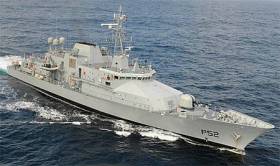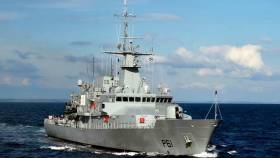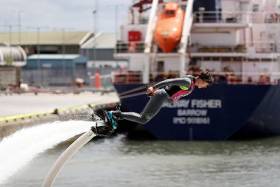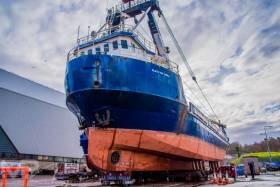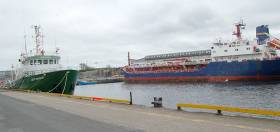Displaying items by tag: Galway Port
Turnover rose to almost €6m last year at the Port of Galway, following strong growth in shipping operations linked to transporting inbound components used for onshore based wind projects.
The revenue generated by the port, recently awarded European TEN-T status, have expanded significantly over the last few years due to its involvement in the delivery of renewable energy projects.
Speaking to the Business Post, the port’s Chief Executive, Conor O’Dowd said the port has been key to the completion of several onshore wind energy projects, which combined has also created 150 megawatts.
O’Dowd highlighted that one current project that the Port of Galway is involved with is the Yellow River Wind Farm, a SSE Renewables project to generate 100 megawatt at the facility in Co. Offaly.
He added “from June 2022 to June 2024, we'll do about 350 megawatts through the port. That's a very significant part of Irish energy infrastructure,”.
Asides the port handling wind-turbines, typical cargoes as Afloat has reported include imports in petroleum products and refuse derived fuel (RDF), bitumen and exports in scrap steel, limestone and project cargo.
For more details of the financial year and TEN-T, the Businees Post reports.
The European Investment Bank (EIB) plans to provide technical expertise to the Port of Galway for its redevelopment plans.
The EIB will offer this expertise through an advisory facility specialising in port development and urban regeneration known as JASPERS – acronym for Joint Assistance to Projects in European Regions.
The port has recently been added to the European TEN-T network, which will positively influence any future bids for grants from the EU’s Connecting Europe facility.
Galway Harbour Company chief executive Conor O’Dowd described the EIB engagement as a “further positive step to realise our ambitious plans for our proposed new port and inner city regeneration projects”.
 Wind turbines arriving at Port of Galway
Wind turbines arriving at Port of Galway
The port is currently tidal, meaning it cannot handle vessels with a capacity of over 6,000 tonnes.
Planned development aims to facilitate growth of the offshore wind sector on the western seaboard.
“The European Investment Bank supports investment in ports across Europe and around the world that enhances maritime transport, unlocks regional economic development and cuts carbon emissions,” EIB vice president Christian Kettel Thomsen said.
“We are pleased to agree, through JASPERS, a new dedicated advisory partnership with the Port of Galway to maximize the benefits of future investment at the port.”
JASPERS has supported over 1500 major projects in the past 15 years, including Project 2040 infrastructural schemes in Ireland such as Metrolink, DART+ , BusConnects and the Smart City pilot scheme in Sligo.
A Galway Port Scheme in Ulysses
In Ulysses Mr Deasy, headmaster of a private school, writes to the newspapers complaining that he knows of a cure for foot and mouth disease but nobody in authority will listen to him. Mr Deasy grandly compares his nebulous proposal to a major project from the 1850s which aimed to attract a growing transatlantic passenger traffic to Galway. Deasy calls to mind the “Liverpool ring which jockeyed the Galway harbour scheme” and describes himself as “surrounded by difficulties, by… intrigues, by… backstairs influence”.
The Galway Harbour scheme was no creation in a novelist's mind. Sixty years before Ulysses there was such a project and James Joyce was well informed about it. The project’s driving force was a dynamic priest named Fr. Peter Daly. Fr. Daly undertook various religious and welfare projects in Galway during the famine years and later involved himself in public life. He was a director of the Galway Gas Company and Chair of Galway Town Commissioners. As a board member of Midland & Great Western Railway Fr. Daly was instrumental in ensuring that the railway did not, as intended, end at Rahoon but reached Galway. He went on to ensure and oversee the construction of the then largest hotel in Ireland at Eyre Square.
Fr. Daly was also a member of Galway Harbour Commissioners and he sought to extend the new railway out to a proposed deep-water passenger facility at Furbo. He saw this as the final link in a chain which would allow ship-owners to offer a through-fare from Hamburg and points along the way across England and Ireland to New York. Such operators would have both a speed and a price advantage which would draw transatlantic traffic into Galway.
All his life Joyce was superstitious about dates and 16th June had special significance for him because it was on 16th June 1904 that he and Nora, his future wife, first walked out together in Dublin. That is why he places Ulysses in Dublin on 16th of June 1904 and why Bloomsday is celebrated around the world each year on 16th June. It is also why he was fascinated by the Galway Harbour scheme for which 16th June 1858 would prove portentous.
Later in Ulysses another voice speaks to the same subject when the putative Skin-the-Goat, keeper of the Cabman’s Shelter on Dublin’s Customs House Quay, laments the state of shipping in Ireland:
“ What he wanted to ascertain was why that ship ran bang against the only rock in Galway Bay when the Galway Harbour scheme was mooted…Ask her captain….how much palmoil the British Government gave him for that day’s work. Captain John Lever of the Lever line. -Am I right skipper? he queried of the sailor…”
 A 1904 cabman's shelter
A 1904 cabman's shelter
This is a reference the ship-owner John Orrell Lever who amassed profits chartering ships for the Crimean war and became interested in Galway for the development of a transatlantic passenger service to rival those of Liverpool and the ports of mainland Europe.
Several hundred Irish investors put up capital for his new company known as The Galway Line. The new service began in 1858 with Indian Empire which was the largest ship up to that time to enter the port of Galway and her arrival was widely anticipated.
On 16th June 1858, as two pilots were guiding her to port, Indian Empire grounded on the Margaretta Rock. Two and a half hours later, on a rising tide, the pilots managed to reverse her off and the steamship proceeded to anchorage with slight damage to her hull. She took on coal, cargo and passengers and on 19th June Indian Empire sailed for New York via Halifax.
However, on the day she had docked Captain Courteney, his crew and pilots were brought before an emergency meeting of Galway Harbour Commissioners. Rumours had begun to circulate about the grounding and a hostile crowd gathered. The pilots had to be protected by the police. Newspapers reported comments that the grounding was likely to turn out to be an attempt to wreck the ship in order to destroy the Galway harbour scheme. There was great discussion in public of plots, sabotage and especially “Liverpool gold at work”. Much was made of the fact that Lever had recruited the pilots in England. Reports were relayed outside Ireland as speculation lingered. Criminal charges were begun against the pilots. The sudden death of one of the pilots brought only more rumours and further press reports. Nowadays the position would be described as a publicity storm amplified by the absence of a media strategy and the credibility of the harbour project was diminished.
We know that Joyce was very taken with this tale and it is especially interesting that in Ulysses he leaves the final word on the subject to a sailor, Able seaman Murphy:
That worthy, picking up the scent of the fagend of the song or words, growled in wouldbe music, but with great vim, some kind of shanty…
- The biscuits was as hard as brass,
And the beef as salt as Lot’s wife’s’ arse.
O Johnny Lever!
Johnny Lever O!
#navy - LÉ Niamh an offshore patrol vessel of the Naval Service is in the Port of Galway this week and is offering the public guided tours.
The OPV writes GalwayDaily will be alongside Galway this today and Friday, with the crew taking members of the public of the navy patrol ship between 1pm and 5pm.
LÉ Niamh is the second Róisín class ship built (Appledore, UK) for the Naval Service and to the same long (78.8m) design of older leadship that optimises her performance in rough Irish waters.
For more click here including a career drive to rise recruitment click this link for further information.
Leadship LÉ Samuel Beckett Open to Public in Galway Today Following Fishery Detention
#navy - The Irish Naval Service offshore patrol vessel, LÉ Samuel Beckett, will be offering guided tours to the public in the Port of Galway today, Saturday, 12th January.
The Samuel Beckett writes Galway Daily is currently docked in Galway after it detained a fishing boat for breach of regulations off the west coast yesterday.
The first fishing vessel detained by the naval service this year, it was handed over to Galway gardaí this morning.
While it’s around, the LÉ Samuel Beckett will be open for public tours while alongside this afternoon between 14:00-16:00.
To read more on the leadship of the P60 OPV90 class and sisters, click here
Seafest 2017: Thousands Turn Out to A Swell Start
#Seafest - Thousands of visitors turned up in Galway yesterday for the first day of SeaFest. If figures are anything to go by and forecasts are right, this year's SeaFest is set to be 'the biggest and most spectacular' sea festival ever staged in Ireland.
The national maritime festival in Galway continues this weekend (Saturday 1st and Sunday July 2nd) with a packed programme of free, family friendly activities and entertainment on offer for all ages.
A relative new comer to the festival scene, SeaFest is only in its third year, but it has already inspired the hearts and minds of many. Having grown from a relatively small event, attracting 10,000 visitors in 2015, it is now one of the biggest family friendly festivals of its kind in the country, and is expected to attract between 80,000 and 100,000 to Galway over the weekend.
Famous ships, flyboarding, sensational seafood and Defence Force displays drew the crowds to the opening day of SeaFest. Galway Harbour has been transformed into a giant, interactive "sea world" with the entire waterfront awash with non-stop water based activity for the festival. Every inch of the port is crammed with boats, over 100, of all shapes and sizes, including sailing, scientific and navy ships.
Visitors can climb aboard and explore the tall ship The Phoenix, the Irish Naval Service coastal patrol vessel LÉ Ciara, the Commissioners of Irish Lights ILV Granuaile and the Marine Institute's research vessel the Celtic Explorer.
Free sailing and kayaking sessions are also on offer to get people out on the water and amongst Galway's ship-filled harbour. The Irish Sailing Association's 'Try Sailing' sessions are also offering disabled access for budding sailors over the weekend.
World's Ladies Flyboard champion Kristen Smoyer and New Zealand's Beau Weston, champion flyboarder and extreme sports expert, are stunning crowds with their breath-taking aerial acrobatics as they swirl in the air on pump-powered jet packs in the heart of the harbour.
BIM and Bord Bia are showcasing the finest of Irish seafood and hosting live cookery and fishmongery demonstrations with top chefs Rory O'Connell, Oliver Dunne and Michael O'Meara. LookWest.ie are presenting a line-up of talks and displays from marine-inspired entrepreneurs.
There is traditional boat building, RNLI and Coast Guard air and sea rescue demonstrations and kids were busy creating their own sea creatures and exploring the deep sea in the Kids Zone. Roving seafaring entertainment including sword-fighting buccaneers, the colourful and comic 'Claddagh Clan', and giant sea-themed puppets exploding onto the street add to the exciting carnival atmosphere.
The festival also features the Wild Atlantic- Sea Science, a new marine science gallery at Galway City Museum, and a unique exhibition on polar explorer Roald Amundsen at NUI Galway. Festivities will also extend across Galway, with activities taking place in the Latin Quarter, Salthill and Rusheen Bay.
SeaFest will continue over the weekend, with activities taking place from 10am to 6pm each day.
For more information visit www.seafest.ie
#AranFreighters - Ireland’s Iargest domestic coastal cargoship that returned from hull works carried out in Co. Donegal earlier this month has yet to re-enter Galway-Aran Islands services, writes Jehan Ashmore.
The 330 gross tonnage cargoship Bláth na Mara normally serves as an essential life-line providing supplies to island communities of all three Aran Islands, Inishmore, Inis Meain and Inis Oirr.
Instead Chateau Thierry which has a roll on / roll-off capabilities is currently covering in as relief cargoship on the Galway route. As there is no slipway facilities, cargo loading will involve use of a deck-mounted crane. In the meantime this replacement vessel has allowed ongoing maintenance work to continue on Bláth na Mara while docked in Galway Docks.
Operators of both freighters, Lasta Mara Teoranta normally deploy Chateau Thierry, a former US tank landing craft (see report photo) on a second service to Aran Islands from Rossaveel. This service conveys trucks, excavators and heavy plant and machinery.
The Government contracted service to the Aran Islands have been operated by Lasta Mara for almost two decades. As the sole operator of freight-only vessels this involves carrying a diverse range of cargoes: from all kinds of food, household items, furniture, coal and vehicles hoisted on board and also livestock. This leaves several other passenger-only operators to serve the islands.
The Galway registered Bláth na Mara based out of the mainland homeport had works completed at Mooney Boats in Killybegs. The call to the yard involved Bláth na Mara using the boat-lift raised to the top of the quayside from where the 36m freighter was transferred on a rail-system to the workshop. This enabled shot blasting and painting of the hull. The works also saw anodes supplied and fitted to the hull.
Cargo loading in Galway Port takes place at the outer pier where Lasta Mara Teo has a warehouse. This is from where the 28m Chateau Thierry departed this morning on the islands cargo feeder service.
Otherwise the routine use of Bláth na Mara involves a single cargo derrick swung from an A-frame foremast. Containers are stowed onto the aft-deck. This layout gives the ship a distinctive profile as the wheelhouse is located at the bow unlike the vast majority of cargoships.
On completion of loading the hard-working coastal freighter heads first to the largest island, Inishmore at Kilronan Harbour. Having discharged cargoes on Inis Mor the service continues to neighbouring Inis Meain and Inis Oirr.
Was Galway Port Sabotaged? (Podcast)
In my last Podcast, I expressed the opinion that it is strange how things happen. This was again underlined for me as I prepared the new edition of my maritime programme which you can listen to below.
Galway Port Company has an ambitious €120m. plan for the future. It is going through the planning process at present, which has delayed it with various checks and examinations of what is proposed.
But the port company is determined to push the process forward and to achieve its goal in creating a modern port with the best of facilities on the Western coastline.
Galway is ideally placed to be a TransAtlantic port, so it has been said many times, but why has this not happened?
Is it possible that, as the business and economic leaders of the city tried to establish a TransAtlantic shipping line, their efforts were deliberately sabotaged by non-Irish ports which did not want Galway to command this trade?
Was the first ship chartered to run such a service, which had been given permission to carry what was then a valuable mail service in financial terms for the shipping service, deliberately sabotaged?
How could it strike the only rock in Galway Bay as it sailed in for the start of the service, leading to huge controversy and damaging the western port’s future?
The story, still an unsolved mystery, is told on THIS ISLAND NATION by author, journalist and Galwayman, Ray Burke. It is a fascinating story, well worth listening to and reading about. He links it into Ulysses, Nora Barnacle and James Joyce in his book ‘Joyce County – Galway and James Joyce’.
Click below to hear the story of how the voyage of the Indian Empire, intended to start Galway’s first TransAtlantic service, suffered a bad start in Galway Bay.
Galway Port Expansion To Go Ahead Under Habitats Directive
#GalwayPort - Business leaders have welcomed the news that the €126 million Galway Port extension project will be proceed under the IROPI section of the EU Habitats Directive.
According to the Galway Independent, the decision by An Bord Pleanála to proceed under IROPI – or Imperative Reasons of Overriding Public Interest – is a first for Ireland.
Progress will involve establishing replacement habitats for those that would be adversely affected by the port extension. As previously reported on Afloat.ie, it was determined that a number of reef, mud and sand habitats would be destroyed by the 24 hectares of land reclamation required.
But there's better news for those with environmental concerns, as planners have determined that two nearby Natura sites – the Inner Galway Bay Special Protection Are and the Lough Corrib Special Area of Conservation – will see no impact, while priority habitats at Lough Atalia and Renmore Loughs will not be "negatively affected".
The board has also recommended "tight co-operation" between the Galway Harbour Company and local authorities to ensure conservation is made top priority throughout the project.
The Galway Independent has more on the story HERE.
Galway Port Expansion Plans Face Environmental Hurdle
#GalwayPort - Parts of the current expansion plan for Galway Harbour would have a significant adverse impact on Galway Bay, according to An Bord Pleanála - a week ahead of the expected decision that has already been delayed for many months.
As RTÉ News reports, the planning body has invited the Galway Harbour Company to suggest moves it can make to offset any lasting damage to habitats in what is a candidate for designation as a Special Area of Conservation.
It has been confirmed that the €126 million redevelopment scheme, which involves reclaiming 24 hectares from the sea, would destroy a number of reef, mud and sand habitats.
Pending that feedback, planners will then decide whether to refer the expansion scheme to Brussels under the Derogation of the Habitats Directive for projects of overriding public interest.


























